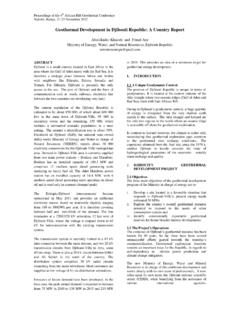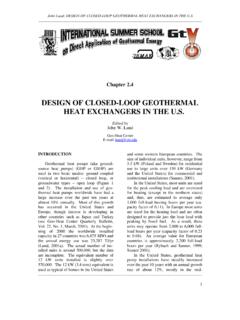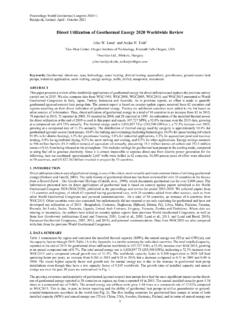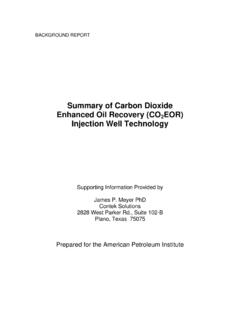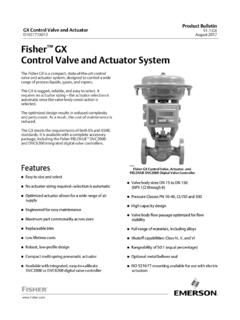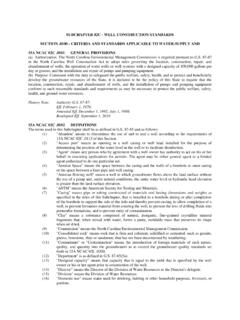Transcription of GROUND-SOURCE (GEOTHERMAL) HEAT PUMPS
1 GROUND-SOURCE ( geothermal ) heat PUMPS by John W. LUND 1. INTRODUCTION When a geothermal resource temperature falls below the 40-50 C range, it is frequently impractical to use the fluid directly for most applications. A heat pump can be used to transfer heat from a low-temperature resource to that of a high-temperature reservoir, thus providing the higher temperature needed for space heating. The process can also be reversed by removing heat from a high-temperature resource and rejecting it to a lower temperature reservoir, thus providing cooling to a space.
2 Air-source heat PUMPS have been used for many years for both space heating and cooling; however, their efficiency is influenced by the variation in outside air temperature. When heat is most needed, the outside air is cooler, thus often requiring backup electric resistance heating during the coldest days. Similarly, cooling is most needed during the hottest days, requiring the equipment to work at low efficiencies. GROUND-SOURCE heat PUMPS , often referred to as geothermal heat PUMPS , overcome the problem of resource variations, as ground temperatures remain fairly constant throughout the year.
3 Depending upon the soil type and moisture conditions, ground (and groundwater) temperatures experience little if any seasonal variations below about 10 m. The GROUND-SOURCE or geothermal heat PUMPS (GSHP or GHP), thus have several advantages over air-source heat PUMPS . These are: (1) they consume less energy to operate, (2) they tap the earth or groundwater, a more stable energy source than air, (3) they do not require supplemental heat during extreme low outside temperature, (4) they use less refrigerant, (5) they have a simpler design and consequently less maintenance, and (6) do not require the unit to be located where it is exposed to weathering.
4 The main disadvantage is the higher initial capital cost, being about 30 to 50% more expensive than air source units. This is due to the extra expense and effort to bury heat exchangers in the earth or providing a well for the energy source. However, once installed, the annual cost is less over the life of the system, resulting in a net savings. The savings is due to the coefficient of performance (COP), averaging over 3 for GSHP as compared to 2 for air-source heat PUMPS . A corresponding improvement is obtained in the cooling mode, as measured by the energy efficiency ratio (EER).
5 These terms are defined later in this paper. NOMENCLATURE (Kavanaugh, undated) Two basic types of GROUND-SOURCE heat PUMPS exist: ground -coupled and water-source. There are a variety of names for the ground -coupled heat PUMPS . These include GROUND-SOURCE heat PUMPS , earth-coupled heat PUMPS , earth energy systems, ground source systems, geothermal heat PUMPS , closed-loop heat PUMPS , and solar energy heat PUMPS . Much of the confusion arises from local marketing needs.
6 Sales people may wish to connect GCHPs to renewable energy sources (solar, geothermal ), dissociate them from air hear PUMPS (GS systems), or connect them to environmental awareness (earth energy). A generally (although not universally) recognized nomenclature is shown in Fig. 1. ground -coupled heat PUMPS are a subset of GROUND-SOURCE heat PUMPS (GSHPs). GSHPs also include groundwater and lake water heat PUMPS (water source). The distinguishing feature of GCHPs is that they are connected to a closed-loop network of tubing that is buried in the ground .
7 The most common method of ground -coupling is to bury thermally-fused plastic pipe either vertically or horizontally. A water or antifreeze solution is circulated through the inside of the tubing and heat is released to or absorbed from the ground . No water enters the system from the ground . Water-to-air heat PUMPS are located inside the building and are connected to the water loop with a circulator pump. This type of system is referred to as a secondary fluid GCHP since there is an intermediate liquid between the refrigerant and the ground .
8 149 Figure 1: GROUND-SOURCE heat pump types A less frequently used system is referred to as a direct expansion (DX) GCHP. Refrigerant lines are buried in the ground in either a vertical or horizontal arrangement. Thus, the intermediate heat exchanger and fluid are eliminated. The possibility of higher efficiency than secondary fluid GCHPs does exist. However, larger charges of refrigerant are required and system reliability is compromised.
9 Therefore, the future of DX GCHP is not clear because of environmental concerns. A variety of ground -coupled heat exchanger designs have recently been proposed and demonstrated as cost-cutting alternatives. These include the Geo-Bag (a large plastic bag buried in the ground and filled with water), a large diameter borehole with spiral coils, and the horizontal-placed slinky coil (Fig. 2). 150 Figure 2: Slinky coil ground -coupled heat pump system 2.
10 DETAILS ON THE COMMON GROUND-SOURCE heat PUMPS SYSTEMS (LUND, 1989) Two major types exist: ground -coupled (closed loop) or water source (open loop). The ground -coupled uses a buried earth coil with circulating fluid in a closed loop of horizontal or vertical pipes to transfer thermal energy to and from the earth. The water-source uses a well or an open pond to provide an energy source or sink. ground -coupled systems have been used in northern Europe for many years, but were not used on a commercial scale in the until 1980.



